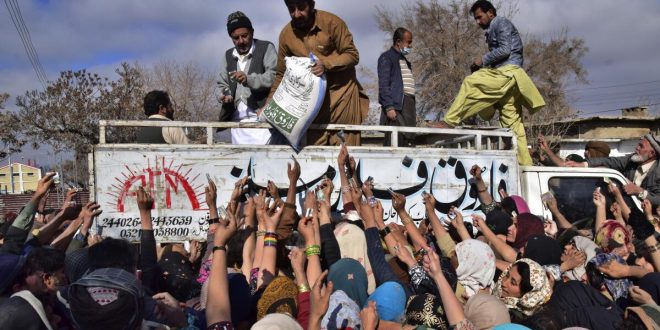
Folks jostle to purchase sponsored sacks of wheat flour from a sale level in Quetta, Pakistan. Individuals are affected by latest worth hike in wheat-flour in Pakistan.
| Photograph Credit score: AP/Arshad Butt
Pakistan’s financial system is on the point of collapse. The nation has requested the Worldwide Financial Fund for a bailout from an impending default. Pakistan is in its thirteenth bailout from the IMF for the reason that late Nineteen Eighties. It’s grappling with widespread blackouts, runaway inflation, depreciating forex and plummeting foreign exchange reserves. Its financial troubles have worsened following the devastating floods final yr. In January 2023, retail inflation soared to a 48-year-high of 27.6%. City meals inflation was at 39% whereas rural meals inflation spiralled to 45.2%. Each city and rural meals inflation have remained in double digits for over10 months now. Chart 1 exhibits basic retail inflation and meals inflation in city and rural areas (in %).
Chart seems incomplete? Click to take away AMP mode
Rising inflationary strain has pushed up the costs of important commodities like wheat, onions, milk and egg. The typical price of a 20kg wheat flour bag in January 2022 was Pakistani Rupee (PKR) 1,164.8. This shot as much as PKR 1,736.5 in January 2023, a 50% rise. Equally, the worth of 1 kg of onions quintupled from PKR 39.4 to PKR 231 in a span of 1 yr. Chart 2 exhibits the costs (in PKR) of important commodities throughout January up to now 5 years.
In the meantime, information experiences recommend that hundreds of containers with important meals gadgets, uncooked supplies and medical gear are held up at ports on account of a scarcity of {dollars}. International change reserves with the State Financial institution of Pakistan dipped to $3.08 billion within the week ending January 27, 2023. Foreign exchange reserves in Pakistan have dwindled to a nine-year low and are simply sufficient to cowl three weeks of import. Chart 3 exhibits the week-wise international change reserves (in $ billion) held by Pakistan’s central financial institution.
Depreciating forex and dwindling foreign exchange reserves are sure to make imports pricey, which is worrying for Pakistan since it’s extremely reliant on imports. Whereas the nation’s imports have seen a big rise, exports have remained largely stagnant, widening the commerce deficit within the latest years. Based on a working paper by the Asian Improvement Financial institution, Pakistan didn’t produce equipment essential for manufacturing and infrastructure growth, which made them import reliant. Pakistan’s exports primarily comprise textiles and agriculture-related items and lack technological sophistication. Nonetheless, up to now few months, imports, too, have diminished on account of a scarcity of {dollars}. Chart 4 exhibits the year-wise worth of export and import of products in $ million.
Pakistan’s bills are additionally rising whereas revenues have did not maintain tempo. Curiosity funds comprise an enormous chunk of bills leaving little room for development-related expenditure. On the similar time, Pakistan has additionally not been in a position to mobilise tax revenues on account of a slender tax base and concessions. In FY22, complete revenues as a share of GDP decreased to 12% whereas complete expenditure as a share of GDP neared 20%. Chart 5 exhibits the share of complete income and complete expenditure within the GDP.
As a consequence of excessive ranges of borrowing, complete debt and liabilities reached PKR 59,697.7 billion (89% of the GDP) in FY22. Complete debt has persistently risen through the years and peaked at 93.8% in FY20. Of the full excellent bilateral debt owed by Pakistan as of March 2022, China accounts for about 35%. Furthermore, a sector-wise share of international personal debt exhibits that as a lot as 92% was used for the facility sector. Chart 6 exhibits monetary year-wise Pakistan’s complete debt and liabilities in billion PKR (left axis). It additionally plots the share of complete debt as a % of the GDP (proper axis).
Supply: State Financial institution of Pakistan, Financial Affairs Division of Pakistan, Pakistan Bureau of Statistics and Asian Improvement Financial institution
Additionally learn : Data | After 2019, Pakistan reduced dependency on India by importing from China and Brazil
#indianews #indiannews
